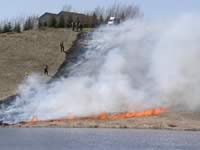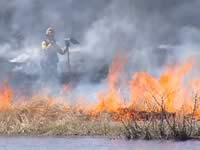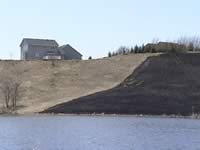
National Fire Plan Success Story
Wildland Crew Collaborates With Local Fire Department to Restore Habitat
Bloomington, Minnesota
National Fire Plan - Rehabilitation, Fuels Reduction
2008

Fire crews burn away grass and other vegetation that could be hazardous to nearby homes if struck by wildfire.

A firefighter closely monitors a prescribed burn in the Soberg Waterfowl Production Area.

As shown here, prescribed burns reduce potentially hazardous fire fuels, which is especially important in Wildland Urban Interface areas.
When the staff of the Minnesota Valley National Wildlife Refuge conducted an overdue prescribed burn on the Soberg Waterfowl Production Area this past year, not only did they restore the wildlife-rich prairie and wetlands, but also the community’s acceptance of prescribed burns in the area.
The Soberg is 65 acres of rolling prairie and wetlands, native grasses and wildlife surrounded by residential subdivisions. Prescribed burns are necessary to reduce overgrown vegetation that could fuel a wildfire around homes and the natural area.
The last prescribed burn on Soberg was in 2000, after which nearby residents raised objections about the impact of drifting smoke, essentially ending prescribed burns there for several years.
In response, the U.S. Fish and Wildlife Service created a new burn plan that divided the area into four units requiring four different wind directions, which complied with the Minnesota Department of Natural Resources smoke management plan. In 2007, Refuge Fire Management Officer Lee Nelson began a public education effort to re-establish support for prescribed burns.
Nelson first met with the Lakeville Fire Department chief and invited his department to observe a burn in the first unit and use the activity as a training opportunity. The event was so successful that the fire department participated again in April 2008 when refuge and fire department firefighters burned 30 acres in Soberg’s Unit 2.
That operation was captured on videotape by fire department staff and was aired for a month on Lakeville’s cable access television, further educating the community about prescribed fire. In addition, firefighters distributed information about the burns to area homes prior to each event to help raise community awareness about the planned activities.
Nelson said the prescribed burns created an opportunity for the two fire staffs to collaborate, and to help increase understanding of prescribed fire and wildland fire behavior.
"The lessons learned were that we need to cooperate with everyone," he said. "The prep work doesn’t start when you lay the black line," said Nelson. "It starts months before with the burn plan, the cooperators and public education."